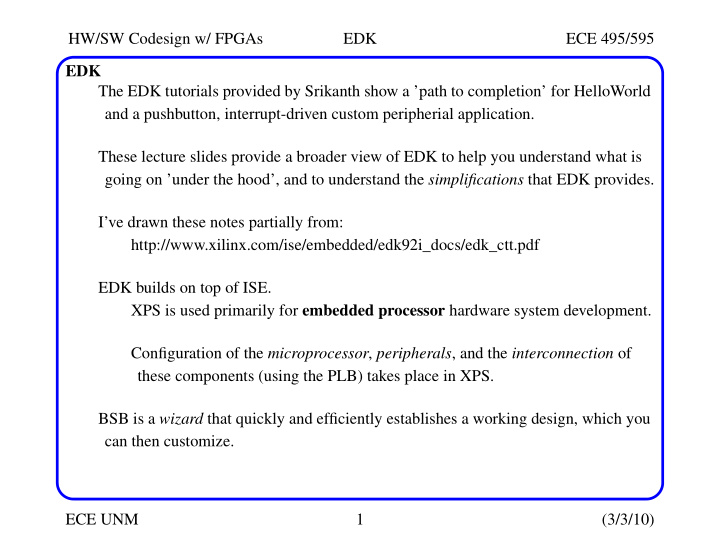



HW/SW Codesign w/ FPGAs EDK ECE 495/595 EDK The EDK tutorials provided by Srikanth show a ’path to completion’ for HelloWorld and a pushbutton, interrupt-driven custom peripherial application. These lecture slides provide a broader view of EDK to help you understand what is going on ’under the hood’, and to understand the simplifications that EDK provides. I’ve drawn these notes partially from: http://www.xilinx.com/ise/embedded/edk92i_docs/edk_ctt.pdf EDK builds on top of ISE. XPS is used primarily for embedded processor hardware system development. Configuration of the microprocessor , peripherals , and the interconnection of these components (using the PLB) takes place in XPS. BSB is a wizard that quickly and efficiently establishes a working design, which you can then customize. ECE UNM 1 (3/3/10)
HW/SW Codesign w/ FPGAs EDK ECE 495/595 XPS Once a project is created The Project tab in the Project Information Area lists the files that were created. MHS, MSS, UCF, iMPACT command files, Implementation Option files, Bitgen Option files. The Applications tab lists all software applications option settings, header files and source files -- you create and add a software application project . The xparameters.h file contains the system address map and is an integral part of the Board Support Package (BSP). ECE UNM 2 (3/3/10)
HW/SW Codesign w/ FPGAs EDK ECE 495/595 XPS The IP Catalog tab lists all EDK IP cores and any custom IP cores you created. Right-click to add IP to the project, or view the data sheet . Added Multi-channel memory controller In System Assembly View , you can view and configure system block elements. Bus Interfaces shows PLB bus connection architecture -- hollow ’dot’ means unconnected. Ports gives a listing of the VHDL ports defined for the IP. Addresses gives the base address and size parameters associated with the IP’s memory and/or ports. ECE UNM 3 (3/3/10)
HW/SW Codesign w/ FPGAs EDK ECE 495/595 XPS Right clicking and choosing Configure IP provides a GUI interface to the IP’s config- uration parameters. The VHDL parameter name, e.g., C_BAUDRATE , is given when the mouse is placed over the parameter. ECE UNM 4 (3/3/10)
HW/SW Codesign w/ FPGAs EDK ECE 495/595 XPS Directories created: • _ _xps/ Contains intermediate files generated by XPS and other tools for internal project management. You will not use this directory. • data/ Contains the user constraints file (UCF). • etc/ Contains files that capture the options used to run various tools. • pcores/ Used for including custom hardware peripherals. Files created: • system.xmp This is the top-level project design file -- graphically displayed in XPS. • system.mhs The system microprocessor hardware specification, or MHS file, captures textu- ally the system elements, their parameters, and connectivity. • system.mss The system microprocessor software specification, or MSS file. ECE UNM 5 (3/3/10)
HW/SW Codesign w/ FPGAs EDK ECE 495/595 Create and Import Peripheral (CIP) Wizard The PLB bus is a complicated structure because it must support many types of peripherials, each potentially operating in different modes, e.g., as master or slave. The wizard allows you to create four types of PLB v4.6 peripherals using predefined IP interface (IPIF) libraries . • PLB v4.6 Slave for single data beat transfer • PLB v4.6 Slave for burst data transfer • PLB v4.6 Master for single data beat transfer • PLB v4.6 Master for burst data transfer The documents in $XILINX_EDK/doc/usenglish/, e.g., mg_ug.pdf and sp026.pdf have additional information on the PLB v4.6 interface. Once you have run the CIP wizard, EDK generates a PLB peripheral. EDK uses a ’PLB slave and burst peripheral’ to implement common functionality among various processor peripherals. ECE UNM 6 (3/3/10)
HW/SW Codesign w/ FPGAs EDK ECE 495/595 Create and Import Peripheral (CIP) Wizard The ’PLB slave and burst peripherals’ are highly parameterizable interfaces. They give you a set of simplified bus protocols in the form of IP Interconnect (IPIC), which is easier to work with than working with the PLB bus protocols. The Slave Attachment implements the protocol and timing translation between the PLB Bus and the IPIC. PLBV46 Slave Burst SPBL_Clk Slave IPIC User IP IP Status Reply Attachment Design SPBL_Rst Rd/Wr Qualifiers Address Cnt/BE CS Bus PLB Bus Generation PLB Requests Burst and Qualifiers Read CE Bus Write Address Write CE Bus Buf Decode Slave Reply Write Data Bus FIFO Read Data Bus ECE UNM 7 (3/3/10)
HW/SW Codesign w/ FPGAs EDK ECE 495/595 Create and Import Peripheral (CIP) Wizard The CIP wizard created two template files: pcores/switch_debouncer_v1_00_a/hdl/vhdl/switch_debouncer.vhd pcores/switch_debouncer_v1_00_a/hdl/vhdl/user_logic.vhd The user_logic file makes the connection to the PLB v4.6 bus via the PLB slave/burst cores configured in switch_debouncer.vhd The user_logic file is equivalent to the ’User IP Design’ block above, while the switch_debouncer is equivalent to the ’PLBV46 Slave Burst’ block. User Peripheral IPIC IPIF switch_debouncer.vhd Custom Functionality Interrupt Slave Ctrl PLBv46 Bus Attach Addr Decode MUX Write FIFO Master Attach Read FIFO DMA user_logic.vhd ECE UNM 8 (3/3/10)
HW/SW Codesign w/ FPGAs EDK ECE 495/595 Create and Import Peripheral (CIP) Wizard The templates represent CoreConnect-compliant structures. Therefore, you do not need to add any additional logic to these files. Most times you will want to add logic, as you did in EDK tutorial 2, in which case you need to re-run the CIP wizard to import your changes. This re-generates the EDK interface files ( .mpd and .pao files). ECE UNM 9 (3/3/10)
HW/SW Codesign w/ FPGAs EDK ECE 495/595 Processor Local Bus (PLB) ECE UNM 10 (3/3/10)
Recommend
More recommend